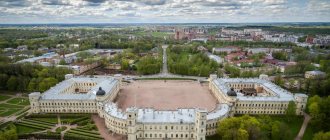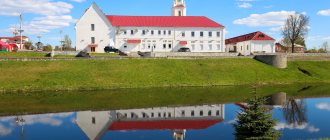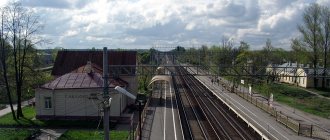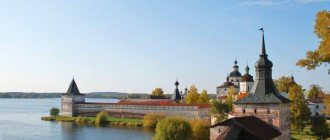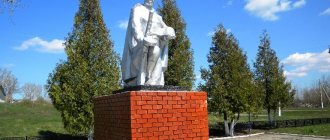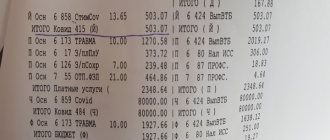For other places with the same name, see Pikalevo.
City in Leningrad Oblast, Russia
| Pikalevo Pikalevo | |
| City [1] | |
| Flag Coat of arms | |
| Location of Pikalevo | |
| Pikalevo Location of Pikalevo Show map of Russia Pikalevo Pikalevo (Leningrad region) Show map of Leningrad region | |
| Coordinates: 59°32'N 34°08'E / 59.533°N Latitude 34.133°E / 59.533; 34.133 Coordinates: 59°32'N 34°08'E. / 59.533 ° N Latitude 34.133°E / 59.533; 34.133 | |
| A country | Russia |
| Federal subject | Leningrad region [1] |
| Administrative region | Boksitogorsk district [1] |
| Municipal settlement | Municipal entity Pikalevskoe village [1] |
| First mention | 1620 [2] |
| City status from | December 9, 1954 [3] |
| Height | 180 m (590 ft) |
| population size (2010 Census) [4] | |
| • General | 21 562 |
| • Evaluate (2018) [5] | 20 183 ( -6,4% ) |
| Administrative status | |
| • Capital from | Municipal entity Pikalevskoe village [1] |
| Municipal status | |
| • Municipal district | Boksitogorsk municipal district [6] |
| • Urban village | Pikalyovskoye urban settlement [6] |
| • Capital from | , Pikalyovskoye urban settlement [6] |
| Timezone | UTC+3 (MSK[7]) |
| Postal code [8] | 187600–187602 |
| Dialing code(s) | +7 81366 [9] |
| OKTMO ID | 41603102001 |
| Web site | pikadmin.ru |
Pikalevo
(Russian: Pikalyovo) is a city in Boksitogorsk District in Leningrad Oblast, Russia, located 246 km (153 mi) southeast of Saint Petersburg and 25 km (16 mi) east of Boksitogorsk. Population: 21,562 (2010 census); [4] 23,325 (2002 census); [10] 24,510 (1989 census). [eleven]
History[edit]
Voskresensky Luchensky Pogost, located within the current boundaries of the city, was founded presumably in the 12th or 13th centuries. [2] At that time it belonged to the Novgorod Republic. [2] Pikalevo was first mentioned by name in 1620. [2] Over time it became a village, and from 1906 the name was given to a newly built railway station on the railway connecting St. Petersburg and Vologda. [2] Since the 18th century, Pikalevo has been part of the Tikhvin district of the Novgorod Governorate. [2] In 1918, the district was transferred to the Cherepovets province. and between 1923 and 1927 Pikalyovo was the administrative center of Pikalyovskaya vol. [12] On August 1, 1927, the province was abolished and the Pikalevsky district with the administrative center in Selo
Pikalevo was created as part of the Leningrad Okrug in Leningrad Oblast. [13] In 1932, the Pikalevsky district was abolished. [13] The current territory of the city is divided between Tikhvinsky and Efimovsky districts. [14]
In 1935, construction of a cement plant began. [12] The village serving the plant was named Pikalyovo in honor of the station. [2] The cement plant was evacuated during World War II, and several industrial plants were built after the war, including an aluminum oxide plant. [2] In 1947, Pikalevo received the status of an urban-type settlement. [15] On July 25, 1952, it was transferred to the newly created Boksitogorsk district [15], and on December 9, 1954 it received city status. [3] In 1992 it became a city of regional significance. [14]In 2010, the administrative division of the Leningrad region was brought into line with a municipal entity, and Pikalevo became a city of district significance. [16]
Pikalevo was hit hard by the economic crises of the 1990s and the first decade of the 2000s. In one infamous episode in 2009, some three hundred residents blocked the highway between St. Petersburg and Vologda to protest wage cuts. Vladimir Putin, then Prime Minister of Russia, flew to Pikalevo and, without going through any legal procedures, ordered Oleg Deripaska, the owner of the plant, to immediately pay off his debts. [17]
Pikalevo
Voskresensky Luchensky Pogost
In the XII–XIII centuries. On the territory of the modern city of Pikalevo, the Resurrection Luchensky Pogost was founded, named after the nearby settlement of Luchany and the Church of the Resurrection of Christ built in it.
It is worth noting that initially churchyards were founded as strongholds of Novgorodians in the developed territories. The beginning of their creation along the Luga and Meta rivers was laid in 947 by Princess Olga. Churchyards were places of “guestry” - the prince and his retinue “stayed” in them during the collection of tribute. Merchants also stayed here during trading periods. Traditionally, graveyards housed places of worship of pagan gods; later Orthodox churches began to be built in them. Subsequently, the churchyards turned into administrative and church centers of the surrounding area.
In the 12th century, the Resurrection Luchensky Pogost was part of the Obonezhsky row (Obonezhskaya hundred), and when the Novgorod lands were divided into Pyatina, it was included in the Nagorny half of the Obonezhskaya Pyatina.
After the annexation of the Novgorod lands to the Moscow principality in 1478, at the direction of Ivan III, the newly acquired lands were rewritten in order to streamline the collection of taxes. But the description of the Voskresensky Luchensky churchyard was not preserved in the first scribe books.
The earliest surviving description of the Voskresensky churchyard in Luchany is contained in the scribe book of the Obonezh Pyatina of the Nagorny half of Andrei Pleshcheev “summer 7091” (1583). The census was carried out by order of Ivan the Terrible. It was a difficult time for the region. The Livonian War (1558–1583), which was unsuccessful for the Russian kingdom, ended, after which the lands of the Novgorod Pyatins found themselves in terrible desolation. The Voskresensky Luchenskaya churchyard was no exception; its population decreased by more than half. According to the census of 1583, in the center of the churchyard there was a wooden Church of the Resurrection with a chapel of St. Nicholas the Wonderworker. There were eight estates in the churchyard, the owners of which were small landowners. The tax-paying peasant class, dependent on the landowners, was located in 52 peasant households in the villages of Luchany, Vyglyadoki and 27 villages of the Voskresensky churchyard.
Pikalevo Wasteland
At the end of the 16th century. The economic restoration of the region proceeded slowly, and with the beginning of the 17th century new trials came - the Great Troubles in the Russian state and the Polish-Swedish intervention. The lands of the churchyard were devastated, as evidenced by the sentinel book of Mina Lykov, compiled in 1620. It first mentions the “pikalevo wasteland, Stepapovskaya identity”, which later became a village, in 1906 giving the name to the railway station and later to the city of Pikalevo.
In 1774, the Voskresensky Luchensky churchyard, along with other 27 churchyards that were part of the Nagorny half of the Obonezh Pyatina, was assigned to the newly formed Tikhvin district of the Novgorod province. At that time there were 758 male souls in it.
Station and village at the beginning of the 20th century
A significant event for the further development of the region was the opening of the St. Petersburg – Vologda railway, along which train traffic began in 1905. At this time, railway siding No. 14 arose - the Pikalevo station, adjacent to the small village of the same name.
The List of populated places of the Novgorod province (Tikhvin district) for 1910 shows the village of Pikalyovo of the Ladyzhensky rural society (with 9 courtyards, 12 houses and 41 residents - 21 males and 20 females, adjacent to the Pikalyovo station) and the Pikalyovo station (Round No. 14 ) St. Petersburg-Vologda railway (with 1 yard, 2 houses and 13 residents - 9 males and 4 females, adjacent to the village of Pikalevo). The station and the village were administratively part of the Obrinskaya volost of the 5th zemstvo section of the 3rd camp of the Tikhvin district of the Novgorod province.
After the revolution
In 1923–1927 There was a Pikalyovskaya volost, formed by the merger of the Derevskaya and Obrinskaya volosts, which included the territory of the modern city of Pikalyovo and the Pikalyovsky urban settlement and belonged to the Tikhvnsky district of the Cherepovets province. With the formation of the Leningrad region in August 1927, the Pikalevskaya volost was transformed into the Pikalevsky district with its center in Pikalyov, uniting the lands that were previously part of the Anisimovskaya and Pikalevskaya volosts.
In 1929, geologist Alexander Andreevich Kalnin discovered industrial reserves of limestone in the Pikalevsky district. To survey the deposits, the Leningrad Geological Trust organized the Pikalevskaya geological exploration party, in which local limestones were studied in detail by geologist Fedor Nestorovich Berdnik. In 1931, work began on the design of the Pikalyovsky cement plant.
During the administrative reform of 1932–1933. In the Leningrad region, 14 districts were abolished, including the Pikalyovsky district, liquidated on January 1, 1932. The lands of the district were divided between neighboring districts.
The discovery of limestone deposits was an important event for the future of the city, determining the direction of its development for many years. The cement plant became the first large enterprise of Pikalyov, the order for its construction was signed by the People's Commissar of Heavy Industry G.K. Ordzhonikidze on September 22, 1934. Construction of the plant with a design capacity of 240 thousand tons of cement per year began in 1935. The first workers of the enterprise were residents of the surrounding areas villages, many of whom were graduates of the local school.
A village was built together with the cement plant. By 1940, the following buildings had already been built in Pikalevo: a brick high school building, a kindergarten, a bakery, two-story and three-story houses.
During the war years
With the beginning of the Great Patriotic War, construction in the village stopped. At this time, the population of Pikalev reached 3 thousand people. The equipment of the cement plant was dismantled and sent to Krasnoyarsk, which was located deep in the rear. In November 1941, the fascist invaders captured Tikhvin and found themselves 40 km from the Pikalevo station. The station became a front-line station and a terminal station; troops were formed there to strike the enemy and for the upcoming liberation of the city of Tikhvin.
During the war, two evacuation hospitals, two aviation workshops, and a front-line ammunition depot that supplied the air force of the Baltic Fleet were located in Pikalevo. Railway workers in those days faced particularly important tasks. Nazi aviation continuously bombed the railway, but the workers of the Pikalevo, Efimovskaya, and Bolshoy Dvor stations bravely served, pulling away burning cars under a hail of shrapnel, rescuing the wounded, repairing broken tracks and eliminating damage to station devices.
The Pikalevo railway station made a huge contribution to the liberation of Tikhvin, which was necessary to ensure the supply of food to Leningrad. Directly from the parade in Moscow on November 7, 1941, two battalions and the 65th Infantry Division under the command of Colonel Pyotr Kirillovich Koshevoy were transferred to Tikhvin. Arriving at Pikalevo and Bolshoi Dvor stations, these units immediately took part in the battles for Tikhvin, which ended in victory for the Soviet troops.
Peaceful post-war decades
After the liberation of the country from the fascist occupiers, cement was urgently needed by the country: it was necessary to restore destroyed houses and enterprises and build new ones. Already in 1944, State Defense Committee resolutions were adopted on the restoration of the cement plant in Pikalyov and the construction of a slate plant.
In 1947, the village of Pikalevo was given the status of a workers' village.
On December 27, 1949, the first cement production line was put into operation at the cement plant under construction. In 1950, the second line was put into operation, and a year later, on December 18, 1951, the third. Thus, the plant’s design capacity was achieved - 280 thousand tons of cement per year.
Construction of the slate plant began in 1945; five years later, on July 30, 1950, the first slate production site was put into operation, where production of corrugated slate of the “VO” brand began.
Resolution of the Council of Ministers of the USSR No. 2811 of July 28, 1948 approved the construction of the Pikalevsky alumina plant with an annual design capacity of 100 thousand tons of alumina. Nepheline concentrate from the Kola Peninsula was supposed to be used as a raw material for producing alumina. Construction of the alumina plant began in 1949 and was completed in 1959. The plant was built by Trust No. 30, which also built the city of Pikalevo. The first director of the plant was Fedor Grigorievich Falshi. In 1959, products were produced on two technological lines of the first block; since then, the alumina production technology has been constantly improved, mechanized and automated.
By decree of the Presidium of the Supreme Soviet of the RSFSR of December 9, 1954, the workers' village of Pikalevo was transformed into a city of regional subordination.
The further development of the city is connected with the construction and modernization of the largest enterprise - Pikalevsky Alumina. In the spring of 1956, the first product was obtained at the Pikalevsky limestone mine - commercial limestone, which was supplied to the Pikalevsky cement, Volkhov aluminum and Cherepovets metallurgical plants. On October 7, 1956, the first electricity in the Lenenergo system was generated by the thermal power plant of the alumina refinery. In September 1959, the first alumina was produced.
In 1957, the Palace of Culture was opened in Pikalevo, which became a leisure center for townspeople. According to the 1959 census, the city's population was 16,977 residents. In July 1964, the stadium was put into operation.
By Resolution No. 277 of the Council of Economic Affairs of the Leningrad Economic Region of November 20, 1964, on January 1, 1965, the Pikalevsky Alumina Refinery was created by merging the cement and alumina plants. In 1968–1972 Alumina and soda-potash production were thoroughly reconstructed and modernized. In 1976, on the basis of the Tikhvin Alumina Refinery (Boksitogorsk) and the Pikalyovsky Alumina Refinery, the Pikalyovsky Alumina Production Association was created.
In 1976, the Dolphin swimming pool was built in the city, equipped with 50-meter lanes. Speed diving championships were held here (seven USSR championships and seven Russian championships).
Experts associate the further development of the city of Pikalevo with the implementation of a comprehensive investment plan based on economic diversification and modernization of urban infrastructure.
Economics [edit]
Industry[edit]
The city's industries consisted of the Rusal aluminum oxide plant, producing sodium bicarbonate and potassium bicarbonate, a cement plant, and a timber processing plant. [18]
Transport[edit]
The A-114 Issad - Vologda highway runs 3 km south of Pikalevo. Highways H-9 (Pikalevo - Zarechye [ clarification required
]) and H-7 (Pikalevo - Kolbeki) pass right through the city.
Pikalevo is located on the railway connecting St. Petersburg and Vologda. There are three railway stations in the city: Pikalevo-1, Pikalevo-2 and Obrinsky.
Pikalevo has both intracity and intercity buses.
Links[edit]
Notes[edit]
- ^ abcdef Provincial Law No. 32-oz.
- ^ B s d e g h History of the city (in Russian). Municipal entity "City of Pikalevo". Retrieved February 27, 2014.
- ^ ab "Archival copy" Boksitogorsky district (July 1952) (in Russian). System of classifiers of executive bodies of state power of St. Petersburg. Archived from the original on September 27, 2013. Retrieved 27 February 2014.CS1 maint: archived copy as title (link)
- ^ a b Federal State Statistics Service (2011). “All-Russian Population Census 2010. Volume 1" [All-Russian Population Census 2010, vol. 1]. All-Russian Population Census 2010 [All-Russian Population Census 2010]
. Federal State Statistics Service. - "26. The size of the permanent population of the Russian Federation by municipalities as of January 1, 2022". Federal State Statistics Service. Retrieved January 23, 2022.
- ^ abcd Law No. 78-oz.
- "On the Calculation of Time". Official Internet portal of legal information
. June 3, 2011. Retrieved January 19, 2022. - Post office. Information and computing center of OASU RPO. ( Post office
).
Search for postal service objects ( postal Search for objects
) (in Russian) - Telephone codes of the Leningrad region (in Russian). Russian telephone codes. Retrieved February 27, 2014.
- ↑
Federal State Statistics Service of Russia (May 21, 2004).
“The population of Russia, the constituent entities of the Russian Federation as part of federal districts, urban settlements, settlements, settlements of 3 thousand or more people” [Population of Russia, its federal districts, federal districts, districts, urban settlements, rural settlements - administrative centers and rural settlements with a population of more than 3,000 people] (XLS). All-Russian Population Census 2002
. - “All-Union Population Census of 1989. The current population of union and autonomous republics, autonomous regions and districts, territories, negative phenomena, urban settlements and rural district centers” [All-Union Population Census of 1989: current population of union and autonomous republics, Autonomous regions and districts , territories, regions, districts, urban settlements and villages performing the functions of district administrative centers. All-Union Population Census of 1989 [All-Union Population Census of 1989]
.
Institute of Demography of the National Research University: Higher School of Economics [Institute of Demography of the National Research University: Higher School of Economics]. 1989 - via Demoscope Weekly
. - ^ a b c Pikalevo: pages of history (in Russian). St. Petersburg: Lenoblinform. Retrieved February 27, 2014.
- ^ ab “Archival copy” Pikalevsky district (August 1927 - January 1932) (in Russian). System of classifiers of executive bodies of state power of St. Petersburg. Archived from the original on March 4, 2016. Retrieved 27 February 2014.CS1 maint: archived copy as title (link)
- ^ a b Pikalevo, city (in Russian). Encyclopedia of the Leningrad Region. Retrieved February 28, 2014.
- ^ ab "Tikhvin region (August 1927 -)". System of classifiers of executive bodies of state power of St. Petersburg. Archived from the original on September 21, 2013. Retrieved February 27, 2014.
- Report on the work of the committee for interaction with local government of the Leningrad region in 2010 (in Russian). Committee for Press and Public Relations of the Leningrad Region. Retrieved November 16, 2012.
- "Protesting workers in northwest Russia pay back wages". RIA News. June 4, 2009
- General information about the Boksitogorsk municipal district (in Russian). Administration of Boksitogorsk municipal district. Archived from the original on February 23, 2014. Retrieved February 27, 2014.
- Pikalevsky Museum of Local Lore (in Russian). Russian Cultural Heritage Network. Retrieved October 27, 2012.
- “Archival copy” Museum of the Pikalevsky Alumina Refinery (in Russian). Pikalevo portal. Archived from the original on May 13, 2012. Retrieved October 27, 2012.CS1 maint: archived copy as title (link)
On the situation in the city of Pikalevo. Dossier
Pikalevo is the administrative center of the Pikalevo urban settlement of the Boksitogorsk municipal district of the Leningrad region. Located 246 km east of St. Petersburg. The population is more than 22 thousand people. There are 3 city-forming enterprises in the city - alumina (belongs to the Basic Element group), Pikalevsky Cement (part of the Eurocement Group) and Metakhim, which are connected by a single technological chain.
By the fall of 2008, a difficult socio-economic situation had developed in the city. The owners of these enterprises were unable to agree on prices for the supplied raw materials. On August 1, 2008, BaselCement-Pikalevo suspended supplies of raw materials to Pikalevo Cement, which ceased production in October, and in November announced plans to lay off 650 employees out of a thousand. The situation also became more complicated at the plant, where production was reduced due to the cessation of supplies of raw materials. On November 8, a rally against the shutdown of production was held in Pikalevo, which attracted about 4 thousand people.
At the beginning of February 2009, the production of BaselCement-Pikalevo was stopped, whose management announced the layoff of about 500 employees. On February 14, a protest rally took place in the city again. On February 18, production stopped and all 267 employees were laid off. Later, the upcoming layoffs of employees of BaselCement-Pikalevo and Pikalevo Cement were announced. As a result of the shutdown of city-forming enterprises, thousands of people lost their jobs.
At the beginning of April 2009, production at Pikalevsky Cement partially resumed. On April 15, residents of Pikalev held a rally in St. Petersburg. In mid-May, due to debts on gas supplies to BaselCement-Pikalevo, the local thermal power plant, which supplies about 70 percent of the city’s housing stock with heat and hot water, including kindergartens and hospitals, was stopped. On May 21, the city was allocated 20 million rubles from the budget of the Leningrad region.
On June 2, 2009, as a sign of protest against the difficult socio-economic situation, about 300 residents of Pikalevo blocked the Novaya Ladoga - Vologda federal highway. On the same day, the governor of the Leningrad region signed a resolution on the allocation of 5 million rubles, which BaselCement was supposed to use to pay off wage arrears to the employees of the thermal power plant. By another order of the governor, 1 million 700 thousand rubles were transferred to the Boksitogorsky district to provide support to residents of the region who found themselves in a difficult situation. By the evening of the same day, the protest ended and traffic on the highway was restored.
On June 4, 2009, in Pikalevo, Vladimir Putin, who held the position of Prime Minister at that time, held a meeting with enterprise owners and regional authorities, demanding that the entire production complex be restored. Already on June 5, the arrears of wages to employees of the enterprises were repaid. On June 8, active work began at BaselCement-Pikalevo to resume production. On June 9, agreements were signed between enterprises belonging to the city production complex, allowing production to resume. By the end of the month, workers returned to the factories.
In October 2009, the situation in the city worsened again. (part of the PhosAgro holding) stopped supplying raw materials to BaselCement-Pikalevo. Within a month, the companies entered into a new agreement, thereby preventing the shutdown of production in Pikalevo. On December 3, agreements on the supply of raw materials for 2010 were signed between enterprises of the city industrial complex.
Agreements for the supply of various products necessary for the operation of Pikalevo enterprises were signed for 2011, 2012 and 2013.
At the end of 2013, negotiations between BaselCement-Pikalevo and Pikalevo Cement again reached a dead end. Despite the fact that there are only a few days left until the end of the year, the companies included in the Pikalevo production complex have not concluded an agreement for 2014. This threatens a new shutdown of the city-forming enterprises.
